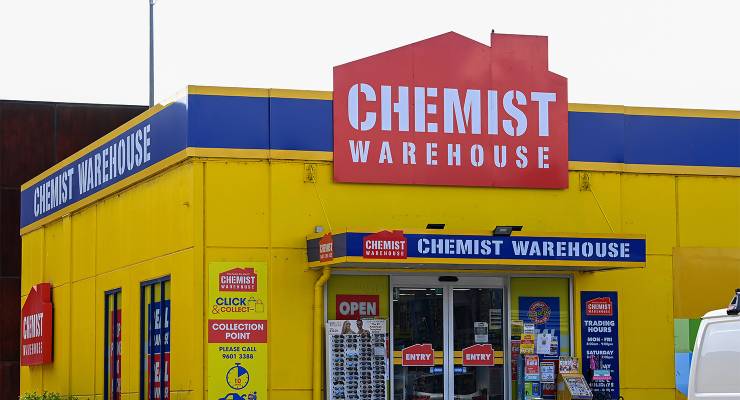
In the retail sector, it’s big news. Chemist Warehouse is merging with Sigma Healthcare.
Most Australians will be well acquainted with the Chemist Warehouse chain, whose garish franchise pharmacies adorn prime positions on many high streets and in shopping centres. The chain has been adding stores rapidly; it’s where many of us buy our cosmetics and toiletries.
The proposed merger will make Chemist Warehouse a retail giant, combining around 600 existing Chemist Warehouse outlets with another 800 pharmacies owned by Sigma around Australia, including well-known franchises such as Amcal and Pharmasave. Investment analysts Morningstar estimates the combined firm will control more than 50% of the market share in Australian retail pharmacies. The deal also gives Chemist Warehouse its own pharmaceuticals wholesaler, allowing the merged entity preferential access to its wholesale products.
The $8.8 billion merger is innovative for all the wrong reasons. The cleverly structured deal gets Chemist Warehouse onto the ASX via Sigma, which is already listed. The new entity will be 86% owned by Chemist Warehouse, and gives founders Jack Gance and Mario Verrocchi seats on the board. Sigma also has to pony up $700 million in cash. It’s closer to a reverse takeover than a true merger.
Like so many Australian industries, pharma wholesaling is highly concentrated. Sigma and its competitors EBOS and API control 90% of the wholesaling market. This deal keeps three wholesalers, but it gives the new entity a stranglehold on the retail pharmacy market. No wonder Intelligent Investor analyst Graham Witcomb thinks it will “hoist more red flags than a communist parade”.
Witcomb’s remark is a reference to likely intervention from the competition regulator, the Australian Competition and Consumer Commission (ACCC). The merger now looms as a crucial test of ACCC commissioner Gina Cass-Gottlieb’s determination to rein in the anti-competitive practices of Australia’s increasingly concentrated corporate sector.
A Josh Frydenberg appointment, Cass-Gottlieb has, perhaps surprisingly, shown herself ready to propose a more active approach under a Labor government. In a speech to the National Press Club last year, Cass-Gottlieb openly campaigned for stronger merger laws. “The problem of concentration is a growing one in Australia,” she argued, citing research by Jonathan Hambur in a 2021 working paper for Treasury. “The ACCC needs to have the tools necessary to be able to properly scrutinise and, if necessary, prevent those mergers that are likely to substantially lessen competition.”
It’s no secret why the ACCC wants tougher merger laws. It keeps losing cases. Federal Court judges have found against ACCC anti-merger action in a string of prominent decisions, shooting down the commission’s cases against Pacific National’s acquisition of strategic freight facilities in Acacia Ridge, and waving through the TPG-Vodafone merger. The case law makes it clear that Australian courts have not been convinced by the ACCC’s arguments about competition being lessened.
While the courts strike down regulatory action, the economic evidence for market concentration in Australia is firming. Cass-Gottlieb’s mention of Hambur’s work is just one of a number of similar studies that show significant concentration in several key Australian industries. Recent research by e61’s Dan Andrews, Elyse Dwyer and Adam Triggs found that the top four firms control more than 50% of the market in key industries such as information, manufacturing, utilities, finance and mining quarrying.
Of course, you don’t need an economics degree to notice that Australia has only four big banks, four big telcos, three energy gentailers, three supermarkets and two airlines.
Competition Minister Andrew Leigh knows all this; indeed, he did some of the most interesting research on market concentration. According to ABS data he compiled, the top four firms in key Australian industries have an average market share of around 43%. As Leigh pointed out in a lecture last year, “Across the economy, from baby food to beer, the top firms hold a high and growing share of the market.” Leigh is also aware of the turn towards tougher action in the US — he’s even been over to meet Federal Trade Commission chair Lina Khan.
Recent history in the US provides plenty of evidence about what is likely to happen as pharmaceuticals consolidate: less competition, higher prices and worse care. One academic study found that the closure of independent pharmacies in the US — pushed to the brink by increased competition from mass retailers — led to a decrease in patient access to prescription drugs. A 2023 paper by the University of Pennsylvania’s Sarah Schutz found that post-merger, net drug prices rose 19%.
European regulators have also taken an active interest in pharmaceutical mergers, blocking or placing strict conditions on several high-profile merger attempts, including the Teva-Allergan merger (which went ahead with divestment conditions), and the Illumina-GRAIL purchase (when biotech firm Illumina ended up being fined a record-breaking €432 million after ignoring the regulators and merging anyway).
Far from increasing efficiency, merger mania leads to fewer but larger firms, less innovation and higher prices. Harvard economist Leemore Dafny has examined the rapid consolidation of US hospitals in the past two decades. It has led to higher prices for care. “When rivals merge, prices increase and there’s scant evidence of improvements in the quality of care that patients receive,” Dafny told a seminar last year.
We’ve seen this show before. The contemporary economy is littered with industries where firms have merged and acquired their way to market dominance, initially offering cheaper prices and better access. But once they seize a commanding position in the market, prices go up and service craters. The classic case, as US regulators freely admit, is Amazon. But Australia offers plenty of domestic examples, as those waiting at the Qantas baggage carousel can attest.
All of this makes the Chemist Warehouse deal a stern examination of the future of Labor’s competition regime.
From the point of view of the broader community interest, it’s hard to see an upside to allowing one of the dominant players in retail pharmacy to swallow a key competitor and supplier. It’s no surprise that a self-interested Pharmacy Guild opposes the merger, but the guild makes a salient point when observing that “medicines are not ordinary items of commerce”. Investment analysts are already warning about the effect of the merger on the availability of wholesale drugs for community pharmacies. The deal is both a horizontal and a vertical integration. It will manifestly increase the market concentration of a key industry with a critical public health role.
Even if the ACCC acts, any merger block may well be vulnerable in the Federal Court. After all, Chemist Warehouse will be able to argue that customers will benefit: the new entity will be able to offer lower drug prices through deep discounting and supply-chain efficiencies. This could be enough to swing a court challenge in its favour.
If stronger legislation doesn’t eventuate, the question then becomes what else a mildly emboldened ACCC can do. There are some further options: competition lawyer Russell Miller points out that the ACCC has the power to apply to courts for an order for merged companies to divest their new acquisition in the first three years after a deal. In a 2023 paper, Miller argued that the existing ACCC regime has been effective, and questioned whether there is compelling evidence for stronger merger laws.
The great and the good assembled for Treasurer Jim Chalmers’ competition review (including Kerry Schott and David Gonski) have some interesting questions to consider. In the US, stronger competition policy has been a cornerstone of what pundits have called Bidenomics. Albonomics, if there is such a thing, has a fair bit of catching up to do.








Ones does struggle to think of parts of the economy where two to three firms don’t dominate. The merger of Good Guys and JB HiFi was a particularly egregious example. And how is Bunnings allowed to continue the way it is? In general it would seem an iron rule of Australian policy and governance is to construct and support oligopoly and monopoly wherever possible. I suppose when the revolution eventually comes it will make nationalisation easy? Perhaps that is the cunning plan?
Two points occur to me. One, if this particular merger goes ahead the protection of chemists no longer makes any sense at all. The only way to restore competition, without say applying a real competition policy that demanded divestments, would be to open pharmacy sales to the supermarket oligopoly. Wonderfully surreal if it wasn’t so sad and pathetic.
Two, if Chalmers and co are willing to be courageous and serious about competition policy, the results for the economy are potentially better than those from the Hawke-Keating reforms. Breaking up the oligopolies would not just be medium term deflationary, it would return a productivity driver that has long been missing for Australia’s fat and complacent (almost entirely anti-entrepreneurial) managerial class. The Liberals would of course call such policy socialist no doubt. Then again, they seem to think rent-seeking is the highest form of capitalism.
A cunning plan, if only… A no-brainer that we got here by short-sightedness rather than design.
But it’s a tantalising notion – the continuation of crony capitalism, at some point in the next decade reaches an oligopolistic crescendo of alienating exploitation, triggering a sudden cascade of long-dormant class consciousness in the Australian populace, and a Sanders-Corbyn figure miraculously pops up in the political landscape, delivering a full-throated roar of downwards wealth redistribution and nationalisation of all the stolen things, drowning out and sweeping aside the increasingly disregarded keepers of the Overton window, as the spirit of 1789 blossoms once more from a river of aristocratic blood.
What a lovely fantasy.
I suspect the emergence of the term ‘re-regulation’ is even too much to hope for.
We’ll just keep sleepwalking down this road to nowhere until civilisation is gone entirely.
I like point 2 AP7, for all the reasons you listed, in particular the potential productivity boost. If meaningful tax reform and more assistance to the unemployed and other welfare dependents are in the too-hard basket, then competition reform is probably the next best thing, and likely to fly under the political radar of most average punters. Yes, the conservatives, political and media, and peak business groups will decry the “attack on business’, but this is not likely to resonate with the average voter who has no love for supermarkets, banks, airlines etc.
Chemist Warehouse is the leading discounter for prescription drugs in Australia. It sells a vast range of generics at a single price for all script holders ie the same lowest price charged to health care card holders. Moreover, Blooms and Good Price will match CW prices at most stores. The community pharmacy trope is largely self serving garbage. In my experience the local community chemist will happily try and sell you nearly anything, whereas the duty chemist at CW, Blooms and Good Price will readily insert into a conversation that non of the complementary drugs actually do squat if you are eating properly, but if you really want to buy them we stock ’em at the lowest prices!
Big pharma like the real estate tycoon developers and big health need to be ousted from profiteering from public funded healthcare a repeat of coalition cockup under labour – wake up Australia stop this rot
Good article. Are we heading towards a future where perhaps only six or seven companies provide every essential we need, and charge us whatever they think they can gouge out of us?
Just as long as I can keep getting past-their-date colognes at cheap prices, who cares about competition? Having a supermarket duopoly and hardware monopoly hasn’t hurt us one bit, has it? /s